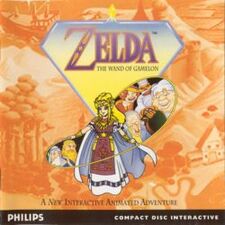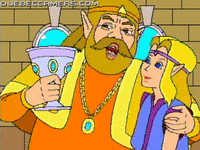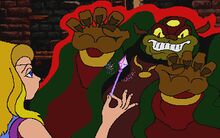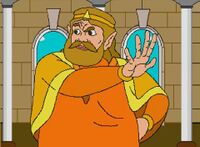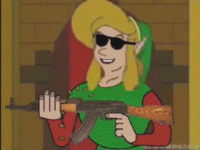Zelda: The Wand of Gamelon
| Zelda: The Wand of Gamelon | |
|---|---|
That sweet little angel Zelda, about to whip someone. | |
| Developer(s) | Animation Magic |
| Publisher(s) | Philips Media |
| Director(s) | Dale DeSharone Igor Razboff |
| Release date | October 10, 1993 |
| Genre | Action-adventure |
| Platform(s) | Philips CD-i |
Zelda: The Wand of Gamelon is a 1993 action-adventure video game developed by Animation Magic and published by Philips Media for the CD-i. It is the second game in The Legend of Zelda CD-i series, and the sister game of blockbuster Link: The Faces of Evil. The game is a near-carbon copy of its brother, with the only difference being you control Princess Zelda instead of Link, the latter of which has been kidnapped in this game. It is a side-scroller in the mold of Zelda II: The Adventure of Link, and features animated FMVs to help enhance its story.
The game was conceived by Philips after a messy divorce between them and Nintendo. After breaking contracts with Sony and Philips (both of which were contracted to make a CD add-on to the SNES, but failed to do so), Nintendo, as part of its alimony, gave Philips the rights to use Zelda characters in their games. Still believing that a project twice-orphaned still could be successful, Animation Magic got to work creating a video game that would be well-known for its gameplay, animation, and voice acting.
They succeeded. Wand of Gamelon is known across the Internet today for its unforgettable acting, interesting controls, and bold scripts. Its sales numbers and player reviews, while high, are not important: what is important is the game's fame across the world and the standard it set for CD add-ons. In fact, the game was considered to be even better than its predecessor, The Faces of Evil.[1]
Gameplay[edit]
In Zelda: The Wand of Gamelon, players play as Zelda for the first time, as Link proves to be too incompetent to save a kingdom this time. The player uses the standard sword and shield to defend themselves. Their health is measured in "Life Hearts", starting off with three hearts at the beginning of the game. Even though Zelda has Hyrule's army at her disposal, the player is forced to fight for themselves. You must explore dungeons, collects numerous power-ups, gather scores of dangerous weapons, and play mini-games.
Zelda can obtain several different power-ups in the game, such as the titular Wand of Gamelon. The Wand can defeat Ganon in one fell swoop, quite an impressive feat since he's quite possibly the strongest boss in the history of video games. Obstacles in the game include rough terrain and occasionally-unresponsive controls. Along the way, the player must fight their way through bosses; these range from grotesque monsters to eccentric shopkeepers who want little girls' rubies.
The game takes place in Gamelon, which was named after its founder, Gamelon, an obscure relative of Malon and Talon. It is ruled by Duke Onkled, who is not a relative of Gamelon, but rather, a relative of the King. For some reason, Ganon is trying to take over it, even though it doesn't contain the Triforce or any other random divine artifacts.[2]
Characters[edit]
Princess Zelda (Bonnie Jean Wilbur) stars as the heroine of the game. She is beloved by the populace of Hyrule for her beauty, kindness, and charm. She ventures to Gamelon to save her father, something that she would think twice about had she known the truth about him. Zelda is skilled in swordplay, likes flowers, and is looking for a man who is sensitive, into poetry, and isn't afraid to cry. In other words, not Link.
King Harkinian (Colin Fox) is the autocratic leader of Hyrule. Despite the fact that his kingdom has been invaded countless times by Ganon, the King's rule has only strengthened due to his horrifying efficient secret police, headed by Link. In Hyrule, free speech has been curtailed, dissidents have been publicly hanged, and government-sponsored raids on political opponents have become part of everyday life. With his mind becoming more insane following every invasion by Ganon or assassination attempt, the only thing keeping the King's mind from snapping completely is his daughter and the thought of freshly cooked Octorok for dinner.
Link (Jeffrey Rath) is proof that you shouldn't judge a book by its cover. Despite his demure and innocent appearance, he's a master of weaponry, a shrewd spy, and a ruthless pursuer. He leads Hyrule's secret police, and has been involved in the Great Hyrulian Purge and the Zora Massacre. Link's only weakness is his fondness for Princess Zelda, and Cuccos. He is also something of a pervert, seeing how he constantly tries to kiss Zelda,[3] buys hookers with canteens, and gets trapped in Lady Alma's mirror so he can watch her undress.[4] Link is captured by Ganon for the first time in this game, but is released by Zelda 3 minutes and 11 seconds after being kidnapped.
Ganon (Mark Berry) is the villain of the game, yet again resurrected by means unknown to wreak havoc upon Gamelon and Hyrule. He triumphs in the beginning of the game by finally defeating his longtime nemesis, Link, but ends up getting defeated such a sweet little angel. Ganon is bizarrely fascinated with the deaths of others, mainly due to having a bad childhood and not getting enough love from his parents. No one can ever kill him; they just seal him away in some plot device and he escapes in time for the next game.
Duke Onkled (Paul Wann) is the King's well-dressed cousin who seems to be in better financial straits, and is also in cahoots with Ganon. Whereas the King has to make do with an orange plebeian robe and headband, the Duke enjoys several jewels and rings, to the point where Snoop Dogg could be dancing alongside him. His betrayal of the King leads to his capture and punishment, and because he pleads his captors to "not hurt him" and "have mercy," they take pity on him and sentence him to four years of hard labor. Whatever number of floors there is in Hyrule, you're sure to see Onkled scrubbing at least one of them. How do you scrub the garden floor, though?
Lord Fari Kiro (Paul Wann) is the Royal Retainer. No one is quite sure what a Spaniard is doing in the land of Hyrule, but Fari nevertheless plays an important role. Duke Onkled originally betrayed him to Ganon, but he escaped by shouting "HEY!" in a rather effeminate manner, and later told Zelda of the betrayal even though she already knew. He reappears at the end of the game to take the Duke to his scrubbing duties, or to somewhere else if you’re so inclined. Too bad he never tweaks his mustache.
Plot[edit]
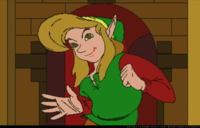
The story begins with the King receiving word that Duke Onkled is being attacked by the evil forces of Ganon. Despite having a fiercely loyal military, the King insists on going to Gamelon alone to aid his cousin, using the Triforce of Courage as protection. Wanting to ensure no revolutions break out in his absence, the King orders that his toughest soldier and police chief, combat-hardened veteran Link, should remain in Hyrule to keep the peace, unless the King is captured. Link approves of this master plan, declaring "that ol' Ganon's no match for the King!"
However, "that ol' Ganon" turns out to be a match for the King, so after one month, Link voyages to Gamelon to save him. He mysteriously disappears, but not before bombing several Gamelonian orphanages (locally referred to as "dodongos"). Worried sick about her dear father and slightly concerned about Link, Zelda begs Impa to give her the Triforce of Wisdom and go to Gamelon. Impa, long accustomed to the King's horrific beatings and abuse but devoted to darling Zelda, is reluctant to let her go, but Zelda's puppy dog eyes melt her all-too-often broken heart.
Zelda traverses through a series of dungeons, villages, deserts, lakes, and pirate ships, asking politely for numerous power-ups and finding open treasure chests.[5] She scores 100 on a minigame and wins a magic wand. She also learns that Duke Onkled has betrayed her father and Link. The Duke succumbs to her endless assaults of "pretty please tell me where they are," and hands her a key to Reesong Palace, where they are being held. Fari, the King's Royal Retainer, randomly appears and tells Zelda he will keep an eye on Onkled.
Finally, after some aromatherapy and a quick self-pep talk, Zelda confronts Ganon. Before she can ask Ganon to let her daddy and Link go, Ganon shocks her with a lightning spell. The battle is lopsided, with kind, gentle Zelda facing a cunning, ruthless master of the arcane magic with the unbridled fury of hell's evil power. Zelda brandishes her pretty jeweled wand and Ganon shrinks at the sight of such an adorable object, sealing himself in an easily escapable plot device set up for the next sequel. Perhaps it was because he was vulnerable to light in his lair (an offense punishable by death), but it could have been the fact that not even a soulless, barbaric monster is cruel enough to try to hurt Zelda.
After Zelda frees Link and the King, the three go back to home to Hyrule Castle. For whatever reason, the King takes until they're back in the castle to realize Zelda saved him. Fari presents Duke Onkled to the King, and Harkinian, hoping that his daughter will follow in his footsteps as authoritarian dictator of Hyrule, prepares a series of unspeakably cruel torture devices to be used on Duke Onkled. The King then gives Zelda the choice of what Onkled's[6] fate will be. Zelda, who admits "it wasn't very nice" for Onkled to betray her father, sentences Onkled to "scrub[bing] all the floors in Hyrule."
Really, what an innocent angel.
Development[edit]
In 1989, an alliance was formed between Nintendo and Sony to develop the "SNES CD" (or "Nintendo PlayStation"), an SNES add-on. However, Nintendo ended up backstabbing Sony and took their plans for the add-on to Philips. After the Sega Micro CD flopped, plans for the SNES CD were canceled for good. As part of its alimony, Nintendo gave Philips the rights to characters from their The Legend of Zelda franchise, and signed an agreement that permitted Philips to give all control of the games to third-party developers, who put their own mark on the series. Nintendo's responsibility in this deal was to suggest how the characters would look.
When Philips asked Nintendo for input on the upcoming Zelda games, they threw their hands up, took a longer than advised drink of sake, and told them "Do whatever you want with Zelda, as long as we get some money." Buoyed by these magical words, Philips hired Animation Magic to develop two games (Link: The Faces of Evil and Zelda: The Wand of Gamelon) on a very small budget. Both games were completed on a very rushed schedule of five days; programmed in three days, cutscenes animated in two, and voice acting performed by parking garage attendants on the way back from work. This gave the games a more epic feel, rather than the cheesy, campy feel previous Zelda games had suffered from.
The writer for Zelda: The Wand of Gamelon was Jonathan Merritt, a student of Uwe Boll. While Boll was completing his doctorate in literature, he and several grad school friends enjoyed a drinking game where one would propose the greatest possible video game idea and try to outdo each other. Boll eventually collected these ideas into a treatment for a movie about Link losing the Triforce in a moment of intercourse, culminating in a quest on Easter Island to collect the entrails of Zelda for a vampire ritual. The screenplay included several scenes of graphic exploitation and Italian epithets in scenes with Mario, and was reportedly quite popular among the students. However, because Uwe Boll has a brain deficiency that severely limits his ability to distinguish good ideas from bad ones, he marketed the script to various companies.
Several years later, while going through his mentor's possessions, Meritt uncovered Boll's original script, and decided that adapting the script for Philips' upcoming Zelda games would be the best way to boost the system's reputation. Boll's 250-page screenplay was eventually trimmed down to a 7-page outline; several changes were made to remove the script's graphic violence, scatological sexuality, profanity, and commentary on the Peasant Revolt of 1525. The plot was split between two games, Faces of Evil and Wand of Gamelon, with a subplot about Mario and Luigi called Hotel Mario.
Reception[edit]
Zelda: The Wand of Gamelon was an instant success, with crazed fans rushing into Wal-Marts everywhere to get their hands on it. It managed to break numerous previous sales records and is one of the best-selling games of all time. One notable supporter was Roger Ebert, who gave the game 3½ stars, calling it "a breathtaking vista to the power of interactive media, it immerses you in Zelda's world of Hyrule [Sic], creating its own world on par with those of Tim Burton, George Lucas, and Walt Disney."
Despite their popularity, Nintendo found that the games strayed too far from the traditional Zelda formula, and disowned them. Denying the promising future of interactive computer games, Nintendo yanked Philips' license and forbade them from ever making another Zelda game. They cancelled their plans for the upcoming Super Mario's Wacky Worlds and instead pooled their efforts into creating the Nintendo 64.
References[edit]
- ↑ Admittedly, there wasn't much room for improvement.
- ↑ Though, the Wand of Gamelon could suffice.
- ↑ Of course, Zelda dislikes Link and often refuses to kiss him.
- ↑ This backfired when the mirror he got trapped in was a looking mirror, not a full-body one that people undress in front of.
- ↑ But discarding any weapons they have.
- ↑ At this point begging for mercy.
| |||||||||||||
